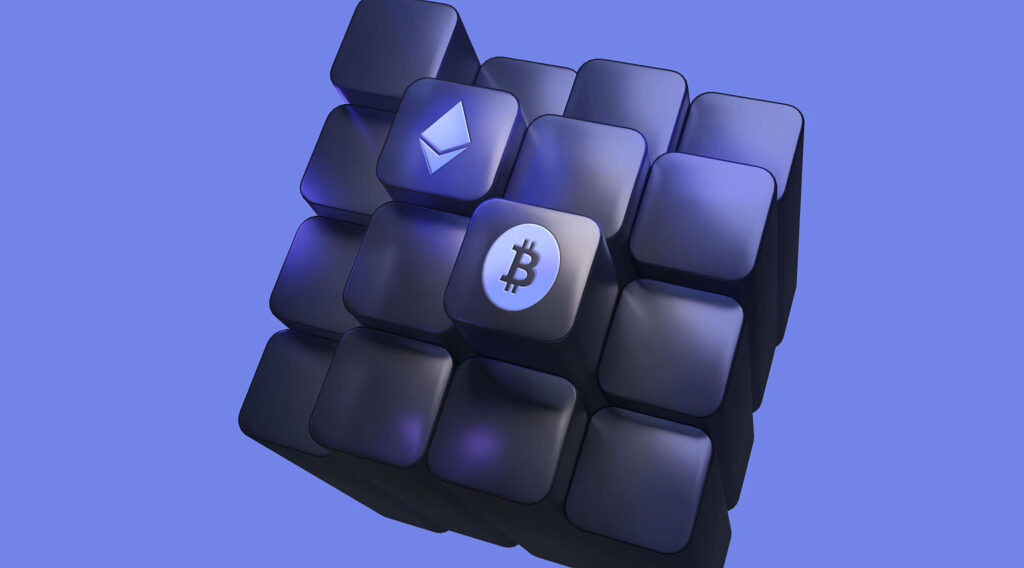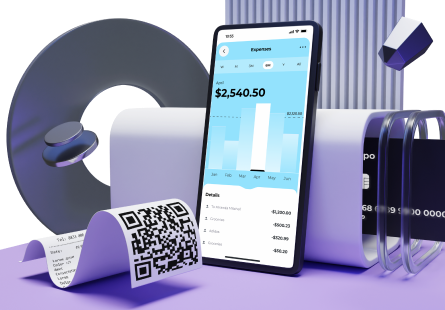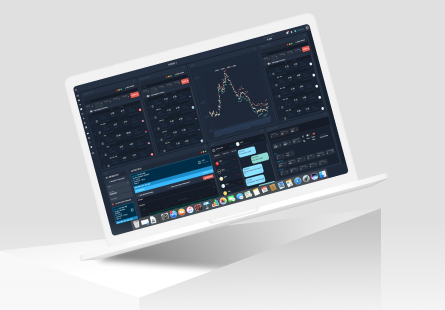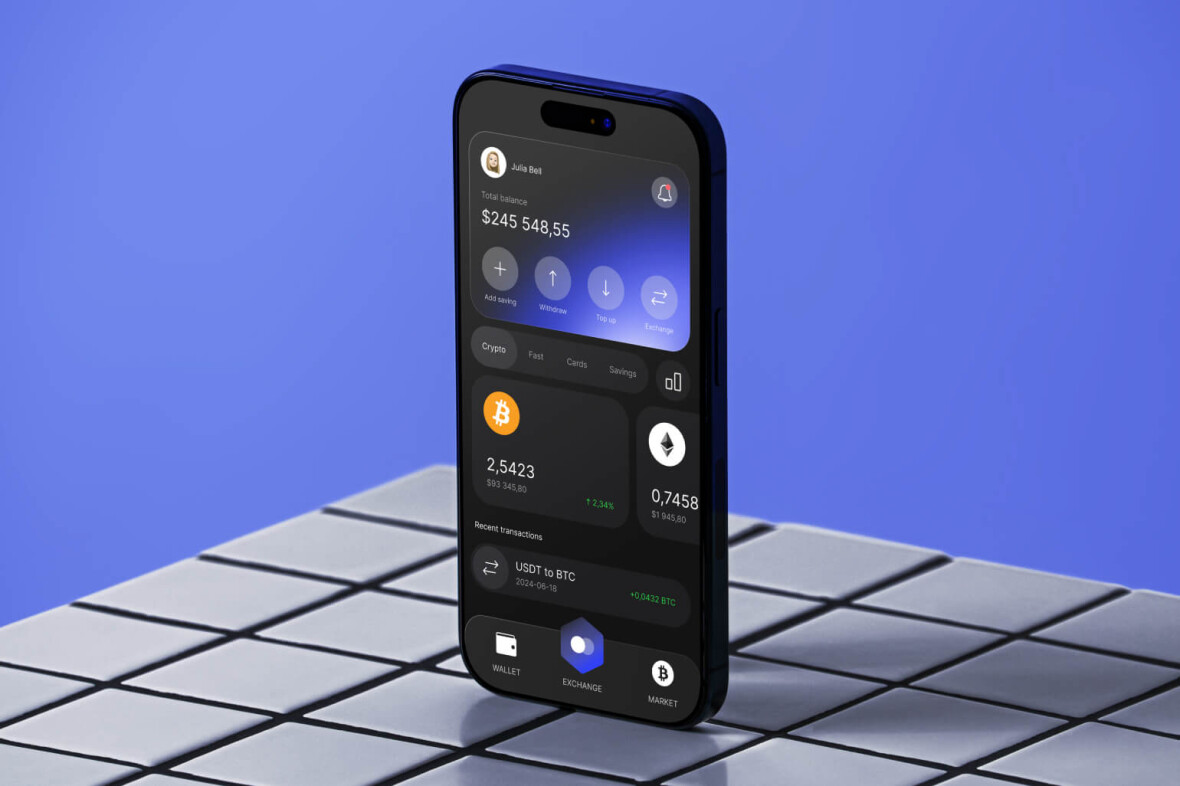Cryptocurrency trading is becoming more popular every day, creating an unprecedented demand for high-performing and user-friendly crypto exchanges. With multiple monetisation options cryptocurrency exchanges offer — from collecting trading fees to selling white-label crypto exchange platforms — crypto apps present a lucrative business opportunity.
If you are looking to launch a crypto exchange business, stay on this page. In this guide, we explore the types of cryptocurrency exchange, discuss the must-have features to include in crypto exchange apps, and take a detailed look at crypto trading app development, so let’s dive in.
What is cryptocurrency?
A cryptocurrency, or simply crypto, is a digital currency designed to enable payments through a computer network. Cryptocurrencies don’t rely on central authorities such as governments or banks to verify transactions.
Unlike fiat currencies, cryptocurrencies exist only as digital assets and are stored in digital wallets, which hold the private keys required to access and manage them. Alternatively, they can be managed through crypto custody services, which are third-party providers offering secure storage solutions, especially for institutions or high-value assets.
Blockchain technology provides a decentralised and secure infrastructure for cryptocurrencies. Cryptocurrency ownership is documented in a digital ledger, a database powered by robust cryptography to safeguard transaction records, oversee the creation of coins, and verify the transfer of ownership. Today’s crypto industry comprises thousands of different cryptocurrencies, with Bitcoin, Ethereum, Tether, and Solana ranking among the most widely traded and valuable by market capitalization.
People can use crypto to pay for goods and services in stores that accept digital currency, to conduct cross-border payments at lower fees, or to leverage DeFi applications, which allow them to borrow, lend, and earn interest on digital assets. However, one of the most popular ways people engage with crypto assets today is through trading, which involves buying and selling cryptocurrencies to capitalise on short-term price fluctuations.
Why build a cryptocurrency exchange app
Crypto trading takes place on cryptocurrency exchange and trading platforms that enable secure buying, selling, and trading of crypto currencies.
Cryptocurrency exchanges feature real-time market data, price alerts, and market analysis tools and typically provide secure wallets for storing cryptocurrencies.
Many crypto exchange platforms also offer mobile apps, which allow users to trade cryptocurrencies literally on the go from the convenience of their smartphones. Crypto exchange app development offers a promising business opportunity due to several reasons:
- the popularity of cryptocurrencies is growing day by day, generating strong market demand for crypto exchange and trading apps
- crypto exchanges offer diverse revenue streams, including transaction fees, listing fees, withdrawal fees, subscription services, selling a white-label crypto exchange, and other monetisation strategies
- cryptocurrencies operate on a global scale, allowing you to attract a broad user base
Types of cryptocurrency exchange
When it comes to cryptocurrency trading, there are three main types of exchanges: centralised exchanges (CEXs), decentralised exchanges (DEXs), and hybrid exchanges (HEXs). Let’s take a closer look at each type.
Centralised crypto exchanges
Centralised exchanges are the most common type of crypto exchange. Coinbase, Binance, and Kraken are the popular examples. A centralised crypto exchange acts as an intermediary between buyers and sellers, providing a platform where users can trade cryptocurrencies.
Here’s how CEXs work: users create accounts, deposit funds, and trade cryptocurrencies. Centralised exchanges are known for their user-friendly interfaces that make it easy for newbies to enter the crypto market.
On the downside, CEXs are vulnerable to security breaches and hacks, as the funds are stored on the exchange’s servers. That’s why it’s crucial to offer users two-factor authentication.
Decentralised crypto exchanges
On the other hand, decentralised cryptocurrency exchanges, like Uniswap and PancakeSwaps, offer a different approach to cryptocurrency trading. They let users trade directly with one another without an intermediary. Instead, these platforms use blockchain-powered smart contracts to enable trades, meaning that users retain control of their funds throughout the process.
The main advantage of DEXs is that they offer greater privacy and security since users don’t have to deposit their funds into an exchange. However, decentralised exchanges are usually less user-friendly and may have lower liquidity compared to centralised exchanges, which could lead to slippage in trades.
Hybrid exchanges
Finally, hybrid exchanges combine the best features of centralised and decentralised crypto exchanges. They are designed to provide the security and privacy typical of DEXs while also offering the seamless user experience of CEXs. To achieve this balance, HEXs use a centralised model for certain functions, such as order matching, and allow users to maintain control of their funds at the same time.

Must-have features for a successful crypto trading app
To be successful with users, a cryptocurrency trading app should contain a combination of features that deliver a seamless, secure, and user-friendly crypto trading experience. Let’s explore the most essential features a crypto trading platform and app should include.
Trading engine
A trading engine is a key part of any cryptocurrency exchange platform. It processes buying and selling requests, matches them according to predefined rules, and updates the order book. In addition, the trading engine generates reports on prices, rates, and commissions. The performance of the trading engine is critical to the operation of a crypto exchange or trading platform.
Crypto wallet
Previously we wrote about how to set up a digital wallet. A crypto wallet is a type of digital wallet designed to store, send, and receive cryptocurrencies. It is one of the basic features of centralised exchanges. It allows users to deposit money, including both fiat currency and crypto, inside a cryptocurrency platform.
When planning your cryptocurrency exchange app, consider allowing your customers to top up their cryptocurrency wallets and withdraw funds in multiple ways, including credit cards, crypto accounts, and others. Fast and convenient wallet replenishment and funds withdrawal significantly improve the trading experience and help build loyalty with users.
Analytics tool
Detailed analytics and reporting tools allow traders effortlessly track their performance, analyse market trends, and, consequently, make data-driven decisions. Latest market insights, profit and loss reports, portfolio performance tracking, and historical trading data help create a better trading experience for users, giving your cryptocurrency app a competitive edge.
Intuitive user interface
An intuitive and visually pleasing user interface makes a cryptocurrency exchange platform or application more attractive to users. Clean design and smooth navigation allow users to easily access charts, place orders, and manage portfolios without getting lost in complex menus.
Chatbot
A 24/7 chatbot powered by artificial intelligence can substantially enhance the user experience of your cryptocurrency trading app. AI chatbots help users with common queries, guide them through the platform’s features, and assist with troubleshooting. This feature boosts user satisfaction and streamlines customer service.
Admin panel
An admin panel is a tool for managing and overseeing the platform’s operations. It lets administrators monitor user activity, trading volumes, deposits, withdrawals, etc. The panel also allows administrators to spot suspicious accounts and prevent fraud.
User verification and authorisation
A secure user authorisation and verification process is crucial for a cryptocurrency exchange app. It ensures that only verified individuals can access the platform, protecting it from fraud and unauthorised access. Know Your Customer (KYC) and Anti-Money Laundering (AML) protocols help verify user identities during registration and ensure the platform complies with financial industry regulations. Multi-factor authentication and biometric options, such as fingerprint or facial recognition, further enhance security.
Push notifications
Push notifications go a long way towards building communication with your cryptocurrency exchange app users and boosting user engagement. You can use push notifications to let your users know about special offers, new listings, changes in rates, and news.
How to build a crypto exchange app step by step
Building a cryptocurrency exchange app is a complex process that requires a well-structured approach. Cryptocurrency exchange app development involves a series of steps.
Identifying the concept and vision
Before starting the development of your cryptocurrency exchange app, it’s essential to define your concept and vision. The first thing to decide on is the type of crypto exchange platform you are looking to build — centralised, decentralised, or hybrid.
At this very initial stage, you should also identify your target audience, key features of your cryptocurrency exchange platform, and differentiating features and functions that will set it apart from competitors.
Planning and design: blueprinting your app
With the concept and vision in place, you can move on to plan and design your crypto exchange application. This phase of cryptocurrency exchange software development involves creating wireframes and mockups that outline the user flow and interface.
At this stage, you’ll also need to map out the app’s core features, such as trading functionalities, wallet integration, security measures, customer support, etc.
When blueprinting your cryptocurrency exchange platform, focus on creating a smooth user experience and intuitive user interface. A well-thought-out feature set and seamless user experience help increase user engagement, which is crucial for retaining customers in today’s competitive market.
Development: building the foundations
At this stage, the development team builds a cryptocurrency app’s back-end architecture, front-end design, and core features. They also establish connections with various blockchain networks, payment gateways, and third-party services that are essential for a cryptocurrency exchange app’s functionality.
Testing and quality assurance: ensuring reliability
Crypto exchange app development doesn’t end with just coding and integrations. You need to thoroughly test your cryptocurrency exchange platform before it goes live. Testing helps identify and eliminate bugs and ensure that the future crypto application is reliable and runs smoothly. Testing comprises several stages that evaluate different aspects of the app’s performance, security, and functionality:
- functionality testing focuses on making sure all features work as intended
- security testing helps check whether your app can handle potential threats
- load testing checks whether the crypto exchange platform can handle high traffic
- quality assurance confirms that your app delivers a seamless experience to users and is safe from vulnerabilities
Deployment: launching your crypto exchange app
During this phase, a cryptocurrency exchange goes live. Now, users can sign up on the platform and engage in cryptocurrency trading. Before the launch, it’s important to double-check whether your servers and infrastructure are ready to handle a potential influx of users.
Post-launch optimization and maintenance: continuous improvement
The work doesn’t stop after the launch. It’s crucial to continuously monitor your cryptocurrency exchange app to fix bugs, improve security, and add new features. A word of advice: pay close attention to user feedback — it will help you make informed decisions about improvements.
Conclusion
Building a successful crypto platform requires a step-by-step approach and a thorough understanding of the cryptocurrency market, user needs, and legal requirements. Luckily, it’s much easier when you have the right team by your side.
DeepInsipre is a fintech software development company with 20+ years of experience. We deliver a broad range of high-quality services, including digital wallet development, crypto exchange development, trading platform development, and more.
We have the necessary technology stack and expertise to help you launch the infrastructure for your cryptocurrency exchange business. Contact us today to discuss how we can turn your ideas into reality.







